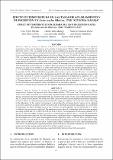Por favor, use este identificador para citar o enlazar este ítem:
https://hdl.handle.net/20.500.12958/4880| Título : | Efecto de temperatura en las tasas de aclaramiento y de ingestión en Ensis macha (Molina, 1782) "concha navaja" |
| Otros títulos : | Effect of temperature on clearance and ingestion rates in Ensis macha (Molina, 1782) “razor clam” |
| Autor : | Prieto Dueñas, Cruz Veliz Mónago, Llerme Ganoza Chozo, Francisco Alvarez Veliz, Jhon Gonzales Molina, Luis García Valladares, Jean Dibucho Álvarez, Oswaldo Pinto Chahua, Edwin |
| Palabras clave : | Tasa de aclaramiento;Tasa de ingestión;Laboratorio;Experimento;Laboratorio;Productividad;Ecosistema |
| Fecha de publicación : | jun-2022 |
| Editorial : | Instituto del Mar del Perú |
| Citación : | Prieto, C., Veliz, Ll., Ganoza, F., Alvarez, J., Gonzales, L., García, J., Dibucho, O., Pinto, E. (2022). Efecto de temperatura en las tasas de aclaramiento y de ingestión en Ensis macha (Molina, 1782) “concha navaja”. Bol Inst Mar Perú, 37(1): 41-50. |
| Citación : | Boletín IMARPE 37(1), 2022; |
| Resumen : | La concha navaja Ensis macha constituye un recurso de importancia comercial en nuestro litoral peruano por su demanda en el exterior. En Huacho los bancos más importantes se ubican en el sur, en el litoral del Promontorio Salinas y La Choza (Playa Grande). El cálculo de Tasa de Aclaramiento (TA) y la Tasa de Ingestión (TI) permite determinar la cantidad de alimento a suministrar a una especie en un determinado tiempo cuando se realiza cultivos en laboratorio; en el medio natural determina la carga máxima de especies a cultivar para no generar impacto en el ecosistema y desarrollar la acuicultura sostenible. En ambiente controlado. se evaluó el efecto de la temperatura en la Tasa de Aclaramiento y la Tasa de Ingestión en individuos de E. macha en diferentes grupos de tallas. Los ejemplares, se agruparon de acuerdo a su talla en: 5,3 ± 0,060; 7,4 ± 0.08 y 10,4 ± 0,10 cm. Se evaluaron dos niveles de temperatura: 16 °C y 21 °C. Se alimentaron con la microalga Chaetoceros gracilis a una concentración de 19x105 células.L-1. Para las pruebas de TA y TI los individuos empleados estuvieron en ayuno durante 24 horas. Los resultados muestran un efecto significativo de la temperatura en la TA y TI sobre ejemplares de tamaño mayor a 7,60 ± 0,14 cm y de 10,53 ± 0,12 cm. Las mayores tasas de aclaramiento y de ingestión se registró a 16 °C con valores promedio de 0,402 L.h-1 y 3,87 cel.h-1, respectivamente y a temperatura de 21 °C los valores de TA y TI fueron menores. Se determinó una relación directa entre la talla de la especie y la TA y TI en los dos niveles de temperatura causando mayor asimilación en su estructura orgánica. ABSTRACT: Ensis macha razor clam is a commercially important resource on the Peruvian coast given its demand abroad. In Huacho, the most important banks are located in the south, on the coast of Promontorio Salinas and La Choza (Playa Grande). The estimation of the Clearance Rate (CR) and Ingestion Rate (IR) is important because it allows for determining the amount of food to supply to a species at a certain time when cultivating in the laboratory. In the natural environment, it determines the maximum load of species to be cultured so as not to generate an impact on the ecosystem and to develop sustainable aquaculture. In a controlled environment, the effect of temperature on the clearance rate and ingestion rate in individuals of E. macha in different size groups was evaluated. The specimens were cultured in laboratory tanks and were grouped according to their size: 5.3 ± 0.060; 7.4 ± 0.08 and 10.4 ± 0.10 cm. Two temperature levels were evaluated: 16 °C and 21 °C. The microalgae Chaetoceros gracilis at a concentration of 19x105 cells.L-1. For the CR and IR tests, the individuals were fasted for 24 h. The results show a significant effect of temperature and temperature on the microalgae. Our results show that temperature had a significant effect on CR and IR on specimens larger than 7.60 ± 0.14 cm and 10.53 ± 0.12 cm. The highest clearance and ingestion rates were recorded at 16 °C with mean values of 0.402 L.h-1 and 3.87 cell.h-1, respectively, while at a temperature of 21 °C, the CR and IR values were lower. We determined a direct relationship between the size of the species and the CR and IR at the two temperature levels causing greater assimilation in their organic structure. |
| URI : | https://hdl.handle.net/20.500.12958/4880 |
| ISSN : | 04587766 |
| Aparece en las colecciones: | Boletín 37(1) 2022 |
Ficheros en este ítem:
| Fichero | Descripción | Tamaño | Formato | |
|---|---|---|---|---|
| Boletin 37-1 artículo 3.pdf | 527 kB | Adobe PDF |  Visualizar/Abrir |
Este ítem está sujeto a una licencia Creative Commons Licencia Creative Commons

